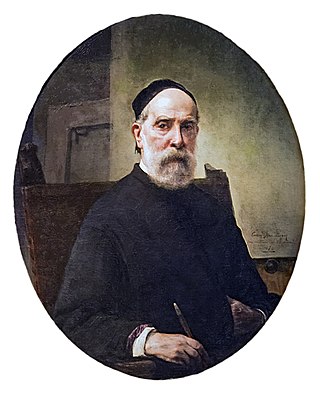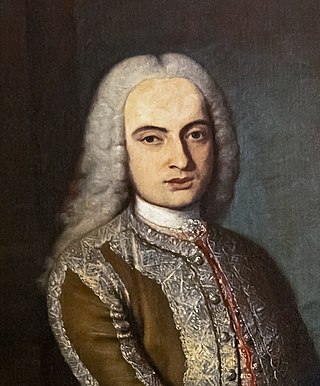Falsetto is the vocal register occupying the frequency range just above the modal voice register and overlapping with it by approximately one octave.
Andrea Gabrieli was an Italian composer and organist of the late Renaissance. The uncle of the somewhat more famous Giovanni Gabrieli, he was the first internationally renowned member of the Venetian School of composers, and was extremely influential in spreading the Venetian style in Italy as well as in Germany.

A madrigal is a form of secular vocal music most typical of the Renaissance and early Baroque (1600–1750) periods, although revisited by some later European composers. The polyphonic madrigal is unaccompanied, and the number of voices varies from two to eight, but usually features three to six voices, whilst the metre of the madrigal varies between two or three tercets, followed by one or two couplets. Unlike the verse-repeating strophic forms sung to the same music, most madrigals are through-composed, featuring different music for each stanza of lyrics, whereby the composer expresses the emotions contained in each line and in single words of the poem being sung.

In Western music and music theory, diminution has four distinct meanings. Diminution may be a form of embellishment in which a long note is divided into a series of shorter, usually melodic, values. Diminution may also be the compositional device where a melody, theme or motif is presented in shorter note-values than were previously used. Diminution is also the term for the proportional shortening of the value of individual note-shapes in mensural notation, either by coloration or by a sign of proportion. A minor or perfect interval that is narrowed by a chromatic semitone is a diminished interval, and the process may be referred to as diminution.

LodovicoZacconi was an Italian composer and musical theorist of the late Renaissance and early Baroque eras. He worked as a singer, theologian, and writer on music in northern Italy and Austria; for a time he was in the employ of Archduke Karl of Graz, and worked in Graz and Vienna.

Francesco Hayez was an Italian painter. He is considered one of the leading artists of Romanticism in mid-19th-century Milan, and is renowned for his grand historical paintings, political allegories, and portraits.

Gian Rinaldo Carli (1720–1795), also known by other names, was an Italian economist, historian, and antiquarian.

Raffaele MaffeiOSM was an Italian humanist, historian and theologian; and member of the Servite Order. He was a native of Volterra, Italy, and therefore is called Raphael Volaterranus or Raphael of Volterra; also Maffeus Volaterranus, or Raffaele Volterrano. Raffaele Maffei wrote the Commentaria Urbana, which was an encyclopedia divided into three parts.

Camillo Procaccini was an Italian painter. He has been posthumously referred to as the Vasari of Lombardy, for his prolific Mannerist fresco decoration.

The Diocese of Frascati is a Latin suburbicarian see of the Diocese of Rome and a diocese of the Catholic Church in Italy, based at Frascati, near Rome. The bishop of Frascati is a Cardinal Bishop; from the Latin name of the area, the bishop has also been called Bishop of Tusculum. Tusculum was destroyed in 1191. The bishopric moved from Tusculum to Frascati, a nearby town which is first mentioned in the pontificate of Pope Leo IV. Until 1962, the Cardinal-Bishop was concurrently the diocesan bishop of the see. Pope John XXIII removed the Cardinal Bishops from any actual responsibility in their suburbicarian dioceses and made the title purely honorific.

Andrea Maffei was an Italian poet, translator and librettist. He was born in Molina di Ledro, Trentino. A follower of Vincenzo Monti, he formed part of the 19th-century Italian classicist literary culture. Gaining laurea in jurisprudence, he moved for some years to Verona, then to Venice and finally to Milan, where in 1831 he married contessa Clara Spinelli. They separated by mutual consent on 15 June 1846.
Maffei is a surname of Italian origin.
Giovanni Luca Conforti was an Italian composer and prominent falsetto singer who wrote an exercise book about Baroque embellishments, Breve et facile maniera d'essercitarsi ad ogni scolaro or Brief and easy manner of exercising for every student, still in use today.

Giovanni Pietro Maffei (1533–1603), also anglicized as John Peter Maffei, was an Italian Jesuit and author. He wrote a life of Ignatius of Loyola, founder of the Society of Jesus, and also wrote about the activities of the Society in the Orient.

Girolamo di Corregio (1511–1572) was an Italian Roman Catholic cardinal and bishop.

Giuseppe Verdi is a 1938 Italian biographical film directed by Carmine Gallone and starring Fosco Giachetti, Gaby Morlay and Germana Paolieri. The film portrays the life of the composer Giuseppe Verdi (1813-1901). The casting of Giachetti as Verdi was intended to emphasise the composer's patriotism, as he had recently played patriotic roles in films such as The White Squadron. The film was made at the Cinecittà Studios in Rome. The film is also known by the alternative title The Life of Giuseppe Verdi.
The Palazzo Marigliano, also known as Palazzo di Capua is a Renaissance-style palace in Central Naples, Italy. It is located on the Via San Biagio dei Librai number 39.

The Valmarana family is an aristocratic family in Vicenza, one branch of which also held Venetian patrician status. Its motto was "Plus Ultra" (Further). They were named after the village of Valmarana in the Berici Hills, where they held fiefs from the bishop of Vicenza.
Edward Foreman was an American operatic bass, scholar of singing technique, and teacher. He was founder and editor of the Pro Musica Press (Minneapolis), which reprinted historical treatises in facsimile and transcription, and also translated them into English. According to Richard Wistreich, these translations offer a uniquely comprehensive and valuable collection of Bel Canto pedagogy in English. He argues that "a growing number of influential singing teachers […] agree [with Foreman]", that there should be a revival of those old, healthy, singing practices.
The Ranieri were a noble family of Perugia, owners of the papal fief of Civitella Ranieri, who governed with the title of counts until 1817, the year in which the ancient feudal county was absorbed by the Church State and finally became part of the municipality of Umbertide (PG).













